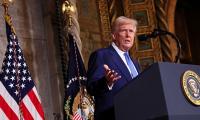After conducting its sixth and significantly more powerful nuclear test, North Korea’s regime has left little doubt that it is on a collision course with the rest of the world. According to South Korean and Japanese meteorologists, the test, believed to be 10 to 15 times more powerful than previous nuclear detonations, triggered an earthquake of 6.3 magnitude. Even China, North Korea’s most important ally and biggest trading partner, has denounced the nuclear test.
The move represents a serious blow to the ongoing multilateral efforts aimed at de-escalating the nuclear crisis in the region. North Korea’s claim that it has tested a hydrogen weapon meant for an intercontinental ballistic missile (ICBM) could further heighten tensions since Pyongyang has recently tested two ICBMs with the ability to fly about 6200 miles, putting parts of mainland US at serious risk of attack. One view is that North Korean is building an effective nuclear deterrent in order to ensure the Kim regime’s survival. There might be some truth to this view, but Pyongyang cannot be allowed to build up its nuclear arsenal at a rapid pace.
North Korea joined the Nuclear Nonproliferation Treaty (NPT) in 1985, under Soviet pressure, but did not allow safeguard inspections until 1992, raising many questions about its commitment to the goals of non-proliferation and disarmament. Even after 1992, North Korea’s leaders were not ready to voluntarily give up their enrichment program because of China’s tacit support. Although, the crisis was resolved temporarily in October 1994 when the country signed an agreement – the Agreed Framework – with the US, North Korea’s nuclear establishment was not ready to be transparent about its long-term nuclear ambitions.
In 2002, a welter of new evidence emerged that North Korea was still working on a secret uranium enrichment programme. In the beginning, North Korean officials resorted to outright denial in the face of compelling evidence but their confrontational posture ultimately led to the breakdown of the Agreed Framework. Increasing tensions on the Korean peninsula resulted in the launch of the Six Party Talks to end the nuclear crisis through negotiations involving China. This process marked a reversal of the Bush administration’s non-engagement policy. Other members were North Korea, South Korea, the US, Russia, and Japan. However, Kim Jong-il was not ready to accept any step towards the verifiable denuclearization of his country. And the talks reached a stalemate in 2006 when North Korea conducted first underground nuclear test and became the world’s ninth nuclear power.
Despite dishonouring many previous commitments to dismantle its nuclear programme, North Korea made another commitment in February 2007 to shut down the key plutonium production facilities at Yongbyon in exchange for an aid package of $400 million and fuel oil shipment. The talks broke down, once again, in December 2008 following North Korea’s refusal to give IAEA inspectors unlimited access to suspected nuclear sites. Although Six Party Talks have not been held after 2009, different countries have held bilateral talks with the North Korean regime from time to time. Despite multiple good-faith attempts at resolution, North Korea’s defiance continues to this day.
In the aftermath of the recent nuclear test, Dr Lassina Zerbo, the Comprehensive Test Ban Treaty Organization’s (CTBTO) secretary general, has expressed fears that “this act would indicate that North Korea’s nuclear programme is advancing rapidly.” Military leaders in South Korea have claimed that Pyongyang is preparing for another ballistic missile test in the days to come. We cannot ignore the sad reality that North Korea continues to conduct nuclear test explosions because there is no international law that prevents it from doing so.
Thanks to domestic political constraints in several countries, the CTBT has yet to enter into force. Many arms control advocates within policymaking circles in Washington DC remain strong opponents of the CTBT. President Obama, on many occasions during his first term, expressed a strong commitment to the CTBT but later it slipped down his agenda due to other domestic political concerns. The prospects for the CTBT do not appear to be bright under President Trump, who does not have any sense of key political and international problems. In addition, many Republican senators are opposed to the very idea of any kind of international constraints on America’s nuclear programme.
The sad truth of the conflictual and power-driven nature of global politics is that the US is not ready to let North Korea develop nuclear weapons or conduct nuclear tests, but, at the same time, American senators would resist any restraints on their own nuclear programme. Very few scholars in the US realise these foreign policy contradictions. Dr Zerbo has rightly remarked that this nuclear test should serve as a wake-up call for the global community to ban nuclear testing in all spheres by accelerating the entry into force of the CTBT. However, it will be very difficult to overcome these obstacles unless a concerted campaign is launched to educated people and relevant stakeholders about the full security benefits of the CTBT.
CTBTO’s youth group members can certainly play a significant role in cultivating favourable public opinion but that requires lot of commitment and ability to think creatively. But CTBTO should focus on quality and not the quantity of its youth members. We will not be able to persuade decision-makers through emotional appeals. What we really need is an actual ability to take concrete steps towards influencing public opinion in a sustained manner.
North Korea offers a rare opportunity for many nations including Pakistan to step forward and push for entry into force of the CTBT. Let’s seize the opportunity before it is too late.
Email: rizwanasghar5@unm.edu
President Trump hints at possibility of imposing tariffs on EU and reciprocal tariffs on many countries
This change eliminated outdated civil service structure, replacing it with results-based governance model
Pakistan’s learning poverty rate stands at 77%, positioning it among the most challenged educational systems worldwide
Political observers believe PTI was pinning hopes on Trump for any possible relief for Imran Khan
Despite billions of dollars and a plethora of projects over the decades, the results remain underwhelming
Globally, there is an increasing focus on creating gender-balanced societies to address women’s status issues







